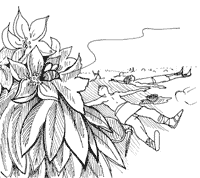>> Back to The HooK front page
STRANGE BUT TRUE- Sickly sweet: Driven crazy by honey
Published February 17, 2005 in issue 0407 of the Hook
By BILL SONES AND RICH SONES, PH.D.

DRAWING BY DEBORAH DERR McCLINTOCK
BY BILL SONES AND RICH SONES, PH.D.
Q. How has eating honey, that prototypical "health food," been known to bring armies to a sickening halt? --P. Bear
A. Travel back to 400 B.C. when Persian King Artaxeres II defeated an army of Greek mercenaries. Retreating, the soldiers pitched camp on hills covered with rhododendrons and feasted on nearby honeycombs and honey, says Dr. Joe Schwarcz in The Fly in the Ointment.
Soon (by the general's journal) the men lost their senses, vomited and couldn't stand up. The "mad honey" effect didn't last long, he wrote. The soldiers recovered within 24 hours.
Today certain emergency hospitals post signs reminding physicians that "mad honey" poisoning can resemble a heart attack. Turns out that nectar from flowers of the rhododendron family can contain "grayanotoxins," causing weakness, slow heart beat, perspiration and nausea-- like a heart attack.
In Turkey, hospitals still report cases of such poisoning, with complaints starting an hour after a person eats at least 50 grams of honey. "Sometimes atropine is needed to boost the heart rate and in rare cases a pacemaker has been temporarily installed." Most poisonings can be traced to producers with only a few hives, says Dr. Joe, so the average consumer's risk is remote, because commercial producers pool the product from many sources, diluting any grayanotoxins.
Q. When was the last time the U.S. got around to "cleaning up its act," as many people gave up drinking, cut back on smoking, reined in their libido? --A. Kinsey
A. Odd as it might sound, reforms of this sort have been cyclical, on roughly an 80-year period, says Indiana University applied health scientist Ruth C. Engs, author of Clean Living Movements.
Wind the clock back 80 years or so to the 1920s and national Prohibition was in force, and 80 years before that was state-mandated Prohibition of the 1850s. "It didn't work then and it didn't work in the 1920s and it isn't working now for those under 21 years," Engs says.
Every 80 years or so we Americans go through a clean- up-society movement: don't smoke, don't drink, don't do drugs or be promiscuous. Caught up in this, we pass laws that are forgotten 30 years later, setting the stage for a renewal of the cycle, says Engs. The cultural forces operating in human society have their predictable patterns of waxing and waning, making it seem as if morality were pegged to the year on the calendar.
Q. At a New York bar, you order a whiskey sour with 100 proof bourbon. What does alcoholic "proof" mean anyway, and how did the term get started? --J. Walker
A. It traces to the 17th century when the alcoholic content of a whiskey was "proved," or tested, by moistening gunpowder with it and setting it afire, says Robert Wolke in What Einstein Didn't Know: Scientific Answers to Everyday Questions. A slow even burn indicated 50 percent or so alcohol content, a sputtering flame suggested a watering down.
In the U.S. today, 50 percent alcohol by volume is defined as 100 proof, so the proof is always twice the percentage of alcohol. If you mix a pint of alcohol with a pint of water, you won't get two pints of mixture but only about 1.93 because the two liquids form bonds that snuggle the molecules in closer together. This (plus alcohol's lower density) confounds the concept of percentage of alcohol by volume.
"Should it be the percentage of the volumes before mixing, or the percentage of the final volume after mixing?" Beverage producers use the smaller volume, after mixing,
which of course increases the label's advertised proof.
But if you live in Canada or elsewhere, be sure to watch your numbers, because other systems obtain there.
Q. Most of us are lucky to remember a 10-digit phone number. How about recalling 36 random digits, or 36,000? Is this humanly possible? --A. G. Bell
A. Rajan Mahadevan made The Guinness Book of Records for reciting the first 99,000 digits of pi, a mathematical number most of us know simply as 3.14, or maybe 3.1416. Call out 50 random digits that you just dreamed up and he can repeat them forward or backward.
Mahadevan said his secret is "chunking" the numbers into manageable units. For example, explains Rod Plotnik in "Introduction to Psychology," here's how Mahadevan broke up one substring of 14 digits-- 11131217351802: "He chunked 111 and named it `Nelson' because Admiral Nelson had one eye, one arm and one leg; he chunked 312 and named it the `area code of Chicago'; he chunked 1735 and named it `29' because Ben Franklin was 29 in 1735; and he chunked 1802 as `plus 2' because John Adams occupied the White House in 1800."
Then, to recite the number, he recalled: Nelson, Chicago area code, Ben Franklin, John Adams.
Send Strange questions to brothers Bill and Rich at .
#
>> Back to The HooK front page
|